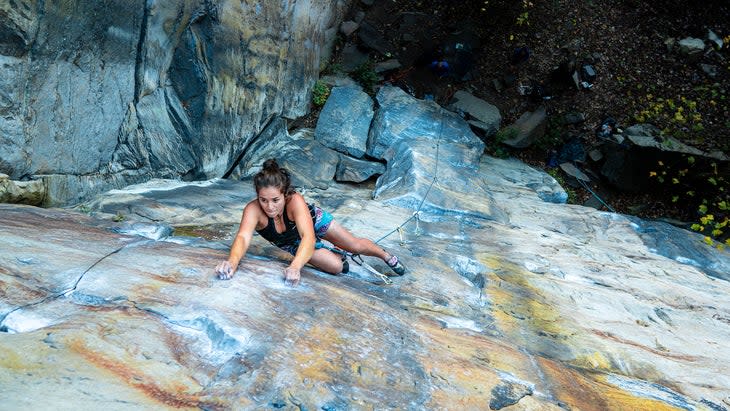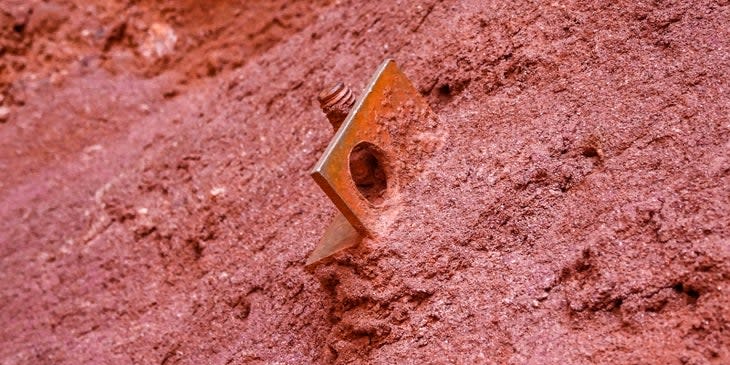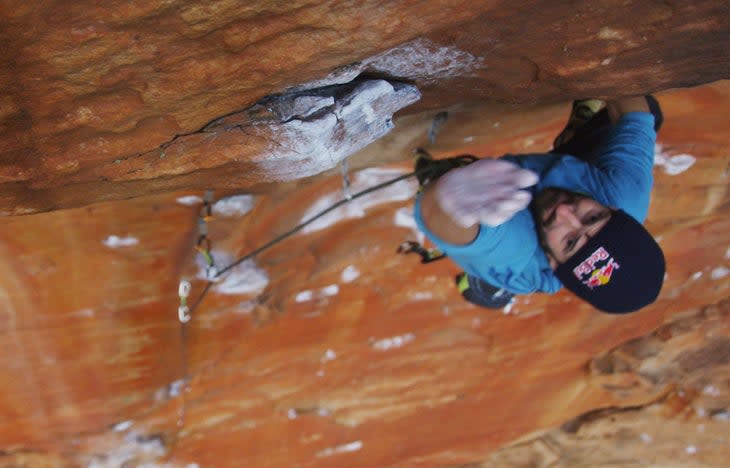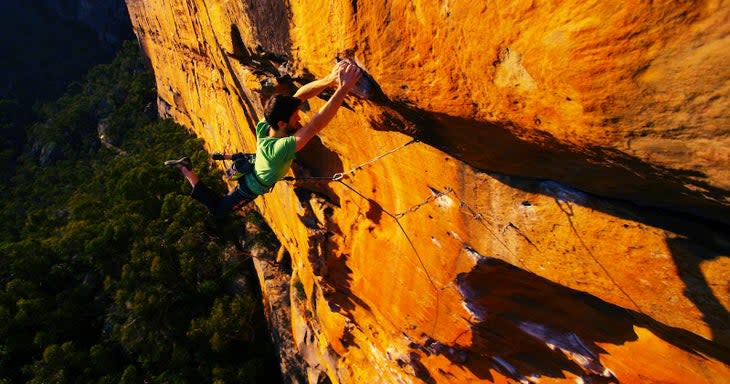Are You Killing Your Favorite Crag? Here’s What to Know About Wet Sandstone.
This article originally appeared on Climbing
If you've ever been to Red Rocks, Indian Creek, or any other desert climbing area in the U.S., you've probably had the First Commandment of Sandstone drilled into your head: Don't climb after it rains.
Why? Because sandstone gets weaker when it's wet, and by climbing on it you risk breaking holds, thereby ruining routes and endangering yourself or others.
But that simple dictate--don't climb after it rains--has spawned years of discussions about what "after" really means. Some people say you're good to climb if the ground is dry; some think it's okay to climb on slopers, but not on crimps; others won't touch the rock until 48 sunny hours have passed. Meanwhile, the rules differ around the country. People frequently climb on the Red River Gorge's Corbin sandstone in the middle of rainstorms, but try the same thing on Indian Creek's Wingate sandstone and you might get your tires slashed.
The confusion among climbers is complicated in part by the fact that few of the debaters have any hard data about exactly how sandstone weakens, how weak it gets, and how climbing interacts with that process.
But there is data out there. Geologists associated with the mining industry have been studying sandstone for decades. Their studies have been geared towards conditions deep underground rather than on the sides of cliffs, but the findings offer some important insights nonetheless.
Their primary takeaway? Sandstone does get weaker when it's wet--sometimes a lot weaker. In studies of rock strength, the United Kingdom's Millstone Grit, found in the country's legendary Peak District, got up to 41 percent weaker when wet, while the country's chossy Cretaceous Greensand was a whopping 78 percent weaker. But Berea sandstone, found from Michigan to Pennsylvania to Kentucky, gets just 20 percent weaker when wet, while Germany's Bad Bentheim sandstone doesn't change in strength at all.
Meanwhile, how long a given piece of sandstone stays wet--and therefore how long we need to wait to climb on it--depends on a number of factors, including things like its microscopic structure, air temperature, humidity, wind, and sun aspect.

What is sandstone, anyway?
There are hundreds of varieties of sandstone and no two look totally alike. But fundamentally, all sandstone is made of tiny grains of rock that have been compacted together. Those grains--often including quartz and feldspar--are typically held together by a cement such as calcite, silica, or iron oxide. Some sandstones have other minerals in them like clay, too. The differences between sandstone types might come from grain type and size, the type of cement, the distribution of pores, or other things. And these differences each influence how sandstone reacts to water.

What exactly happens when it gets wet?
When sandstone gets wet, a few important things happen.
First, remember that sandstone's porosity--the size of the gaps between grains--varies by type but can exceed 20 percent of its total volume, meaning that the rock is actually one-fifth air. And when it rains, those pores fill up with water.
One of the simplest reasons that wet sandstone weakens is simply because water filling these pores reduces the friction between the grains of rock, says Dr. Oliver Sass, the chair of the geomorphology department at the University of Bayreuth in Germany. Just like your foot skates off a damp smear, the constituent pieces of a sandstone crimp will more easily shear past each other if they're wet.
The clay in some sandstones can also exacerbate fragility. Clay swells and grows more slippery when saturated, which can also cause the grains to slide past each other more easily.
But there's something else at play: the fact that water causes chemical reactions when it gets inside sandstone. Water molecules react with silica, the cement in some sandstones, replacing it with weaker compounds, and a similar but more gradual process occurs with calcite, another common binding agent.

This chemical weathering process can be especially pronounced when paired with existing cracks inside sandstone, says Dr. Mandy Duda, a geoscientist at Ruhr University Bochum in Germany. "When these crack tips are humid or even filled with water, then the energy required to make this crack grow is lower," she says.
Water can set off a feedback cycle when it gets into small cracks, weakening the tips of the cracks, which open a bit wider, letting water deeper into the rock where it further weakens the crack, which opens wider, and so on. Should the process spiral far enough, you might be left holding onto that crimp you just dynoed to as you fall off the wall.
Still, it's not always clear why one sandstone is weaker than another. Some researchers propose that sandstones with a higher percentage of quartz will lose less strength when wet, while those made of clay will lose more strength. But in her own studies, Duda found a more complicated picture. She compared clay-less sandstone from Fontainebleau to clay-rich Wilkeson sandstone from western Washington. Both lost about the same amount of strength.
Ultimately, because every sandstone is different, the loss of strength comes from many sources and varies considerably. One study looked at 35 different kinds of U.K. sandstone, and found they got anywhere from 8 to 78 percent weaker. Another examined eight types of sandstone from Germany and found strength losses ranging from 1.4 percent to 50 percent. For their part, Duda's Font samples lost 16 percent of their strength when wet.
Unfortunately, there aren't any studies on some of the most popular types of sandstone for climbing here in the U.S. Anecdotal evidence from climbers suggests that the Corbin and Nuttal sandstone--found in the Red River Gorge and New River Gorge, respectively--are likely to lose less strength when wet, while the Wingate, Navajo and Aztec sandstones found in the desert lose serious integrity when saturated. But by how much is anyone's guess.
The kind of hold can make a big difference, too. You'll almost never snap off a sloper, but small crimps break regularly, even on strong, dry rock. Other factors, like the direction of pull, weight of the climber, and dynamism of movement also come into play. But regardless of the variables, wet sandstone is almost guaranteed to bring that threshold of failure closer.

How long do I need to wait before climbing again?
Short answer: It's not the rain, it's the evaporation.
But here again the answer is pretty elusive. Not only do different sandstones dry at different rates, but a host of environmental factors come into play. Walls in parched and sunny places like Nevada will dry out more quickly than those in humid places like Kentucky. Wind will dry out a wall more quickly, as will higher temperatures.
One complicating factor is that most sandstones don't lose strength evenly as they get wetter. Instead, much of the weakening happens in the first 20 percent or so of saturation, according to one study. That means that sandstone that's just a little bit wet can be quite weak. For some sandstones, Duda says, humidity alone can change or alter the rock strength. "It makes a difference if you have sunny weather or if it's humid."
In a recent study, Duda compared sandstone at room temperature to samples of the same sandstone that had been oven-dried at either 140 and 248 degrees Fahrenheit to remove any moisture in the rock. The room-temp samples were much weaker than the oven-dried ones, meaning that the ambient humidity was enough to make the sandstone substantially weaker. And another study found that cracks grew much more quickly in two types of sandstone when humidity levels were higher.
That doesn't necessarily mean that the sandstone in drier places like Indian Creek will be stronger than the sandstone in more humid places like the Red River Gorge. The sandstones in those two places have different base levels of strength, and they respond to getting wet differently. We don't have the data right now to do a side-by-side comparison, but one takeaway is that by climbing on desert rock on wet or humid days we risk breaking holds. And while the humidity in places like Kentucky is probably weakening the sandstone there, that rock responds much more favorably to getting wet, which is why anecdotal evidence from years of climbing suggests it's still ok to climb even under damp conditions.
Another complicating factor: Sandstone may never get fully dry.
Sass, the Bayreuth geomorphologist, recently conducted a small study at the Saxon Switzerland climbing area in Germany, also sometimes called Saxonia. Considered by many the birthplace of free climbing, with ascents dating back 150 years or more, the sandstone in Saxon Switzerland is soft and the ethics are strict. With the exception of the occasional ring bolt, climbers can't use metal protection, and instead rely on knotted slings for pro. Chalk is forbidden, as is rap bolting and--you guessed it--climbing when the rock is wet.
Teaming up with some local climbers, Sass took measurements of the rock's moisture content and found that while the outer five to 10 inches of rock dries out after each rain, the deeper layers remain more or less saturated. That finding held even on walls that were exposed to significant sun and wind. The most influential variable for saturation was actually height: The upper parts of the walls were drier inside than the bottom sections, in part because water drains from top to bottom.
Sass would have had specific data about how fast the rock dried, but when he left moisture-measuring sensors attached to certain cliffs around Saxony, they were stolen, and their data with them. Sass thinks overprotective local climbers may have gotten worried that his experiments were meant to ban climbing in the area entirely. He hopes to go back soon, funding permitting, to repeat his experiments.
So What Should We Do?
The complexities of sandstone geology and the vagaries of weather and environment make it nearly impossible to come up with a single coherent set of rules. But what we can say clearly is that on desert sandstones--which are not used to water--you shouldn't climb if there's any doubt about whether the rock is sufficiently dry.
The best thing you can do, says Ty Tyler, the Stewardship Director at the Access Fund, is to be informed, be aware, and be respectful.
"There are so many variables to take into consideration. And there are so many different types of sandstone," he says, adding that the Access Fund has no official statement on climbing on wet sandstone--it's just too complex. "I think it goes back to whether we want to protect the resource that we love and enjoy. At the end of the day is it worth damaging it for future climbers just so that we can get on that send?"
That doesn't necessarily preclude climbing in the rain. But it does mean that you should research the type of rock and, better yet, talk to the locals. They're almost always your best guide to what to do, Tyler says, and it's worth following their lead. If they're not climbing, you probably shouldn't be either. You're better off settling for the MoonBoard than becoming the asshole who forever ruins Fear of a Black Hat.
Author Bio:
Nathaniel Scharping is a climber and freelance writer based in Tacoma, WA.
For exclusive access to all of our fitness, gear, adventure, and travel stories, plus discounts on trips, events, and gear, sign up for Outside+ today.

